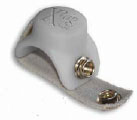May 27, 2003 – Xtag, a company based in Leeds, UK, has developed a new RFID security system for tracking babies in hospital infant wards or wandering patients in elder care facilities. Xtag says its readers are designed to work with existing access control systems.
The Xtag system consists of a bracelet with an embedded battery-powered tag that operates at 433.92 MHz, readers placed at doorways and in hospital hallways, and software that manages the system. The transponder in a baby or patient’s bracelet or a staff member’s ID badge emits a signal every two seconds. Readers placed throughout the facility pick up the signal and transmit location data to the software.
The product, which uses an FM transmission signal, also monitors the tags’ battery status. If a badge is removed without authorization, an anti-tampering signal is emitted from the chip and is picked up by the readers, which have a read range of 1.5 to 50 feet (0.5 to 15 meters). The system also alerts staff when the battery in a bracelet is running low.
The system can function even if a hospital’s local-area network were to go down. The readers are designed to continue monitoring the tags. If a baby or patient were to pass through an exit without authorization, the reader would send an alert to nurses or security staff automatically via email, SMS message, pager or other predefined method. The message relays the exact location where the alarm was triggered, along with the time and date.
The software allows hospitals to create audit reports based on staff and patient activities. The reports can include information such as the patient’s name, the event, location, time and date. Personnel records can also be maintained in the software’s database for both staff and patients. Those records can include digital photographs of the subject, parents or guardians’ names.
The reader is directly compatible with all existing Wiegand access control systems, according to Xtag, which says third-party vendors can adapt existing passive systems to work with the active tags and Xtag readers. The adult patient and staff tags have a four-year battery life, while the battery in the infant tags last about two years.
The electronics and system design, firmware, network design, and application software are all created and manufactured by Xtag. The system is distributed in the UK by Link Technology.
Xtag isn’t the first company to deliver monitoring systems for medical staff and patients. Precision Dynamics Corp. offers a Smart Band RFID system, which uses a 13.56 MHz passive RFID transponder from Texas Instruments. While Xtag focuses on security of personnel and patients, PDC’s system is geared to facilitating medical care.
PDC’s passive system can record and transfer data, such as serial numbers, personal records and medical information from PDC’s computer system to the wristband and vice versa. Using a handheld reader, a nurse could scan a patient’s RFID tag and receive data about any allergies the patient might have, medications, or procedures to be performed. — By Jennifer Maselli,
[email protected]
There are less than three weeks left until the most important RFID conference of the year. Seats are limited, so register today for RFID Journal Live!, Chicago from June 11 to 13.


